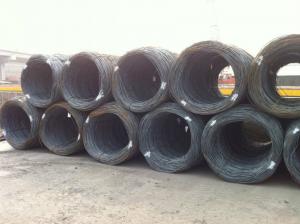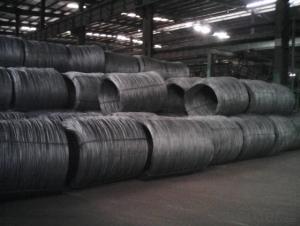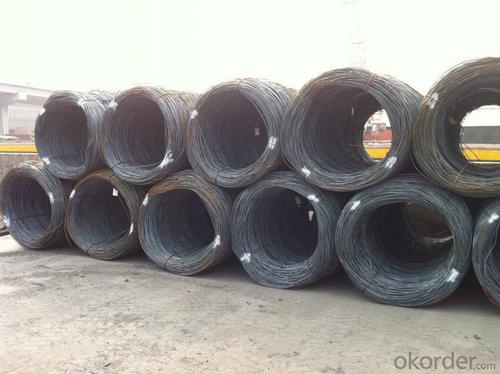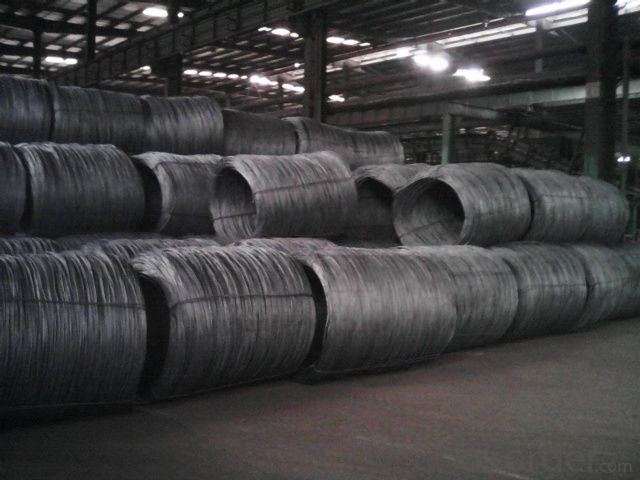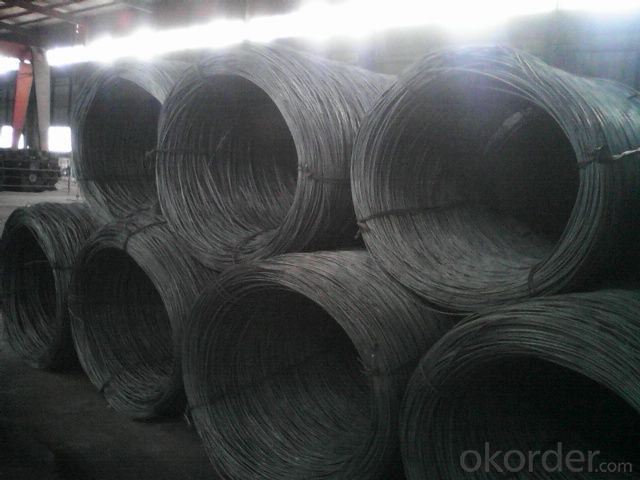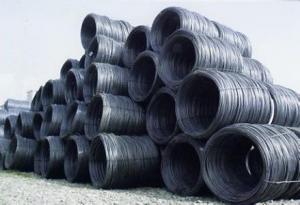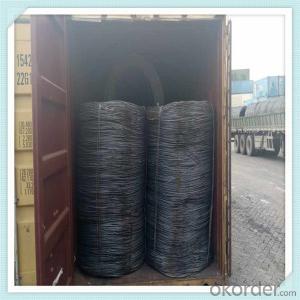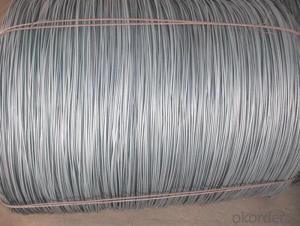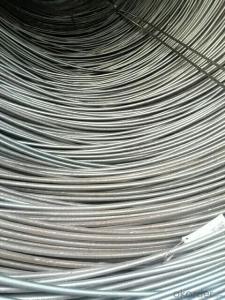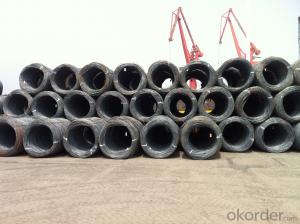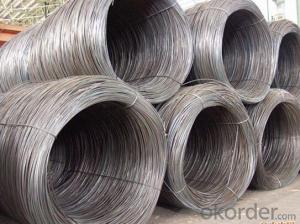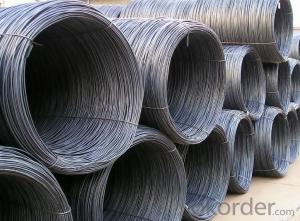GB Hot Rolled Wire Rod 1008b
- Loading Port:
- China Main Port
- Payment Terms:
- TT or LC
- Min Order Qty:
- -
- Supply Capability:
- -
OKorder Service Pledge
OKorder Financial Service
You Might Also Like
Product Description:
OKorder is offering GB Hot Rolled Wire Rod 1008b at great prices with worldwide shipping. Our supplier is a world-class manufacturer of steel, with our products utilized the world over. OKorder annually supplies products to European, North American and Asian markets. We provide quotations within 24 hours of receiving an inquiry and guarantee competitive prices.
Steel Grade: SAE1008B Standard: ASTM, GB
Diameter: 5.5mm, 6.5mm, 7mm,8mm,9mm,10mm,12mm,14mm
Type: Drawn Wire Alloy or Not: Alloy Brand Name: N-RIVER
Technique: Hot Rolled Place of Origin: China Mainland
Chemical Composition:
Please kindly find our chemistry of our material based on SAE1008B as below for your information
Grade | Chemical Composition (%) | |||||
C | Mn | S | P | Si | B | |
SAE1008B | 0.10max | 0.32max | 0.045max | 0.040max | 0.30max | 0.0008min |
Mechanical properties | ||||||
Yield strength(N/mm2) | Tensile strength(N/mm2) | Elongation (%) | ||||
≥195 | 350-380 | ≥32 | ||||
Packaging Detail: products are packed in coil and then shipped by container or bulk vessel
Each coil weight: 2-3MT
Delivery Detail: within 45 days after received deposit or LC.
Label: to be specified by customer, generally, each bundle has 1-2 labels
Trade terms: CFR, CIF
Product Applications:
GB Hot Rolled Wire Rod 1008b are ideal for structural applications and are widely used in the construction of buildings and bridges, and the manufacturing, petrochemical, and transportation industries.
Product Advantages:
OKorder's GB Hot Rolled Wire Rod 1008b 8 are durable, strong, and resist corrosion.
Main Product Features:
· Premium quality
· Prompt delivery & seaworthy packing (30 days after receiving deposit)
· Corrosion resistance
· Can be recycled and reused
· Mill test certification
Product Specifications:
Diameter: 5.5mm, 6.5mm, 7mm,8mm,9mm,10mm,12mm,14mm
FAQ:
Q1: What makes stainless steel stainless?
A1: Stainless steel must contain at least 10.5 % chromium. It is this element that reacts with the oxygen in the air to form a complex chrome-oxide surface layer that is invisible but strong enough to prevent further oxygen from "staining" (rusting) the surface. Higher levels of chromium and the addition of other alloying elements such as nickel and molybdenum enhance this surface layer and improve the corrosion resistance of the stainless material.
Q2: How do we guarantee the quality of our products?
A2: We have established an advanced quality management system which conducts strict quality tests at every step, from raw materials to the final product. At the same time, we provide extensive follow-up service assurances as required.
Q3 Why buy Materials & Equipment from OKorder.com?
A3: All products offered byOKorder.com are carefully selected from China's most reliable manufacturing enterprises. Through its ISO certifications, OKorder.com adheres to the highest standards and a commitment to supply chain safety and customer satisfaction.
Images:
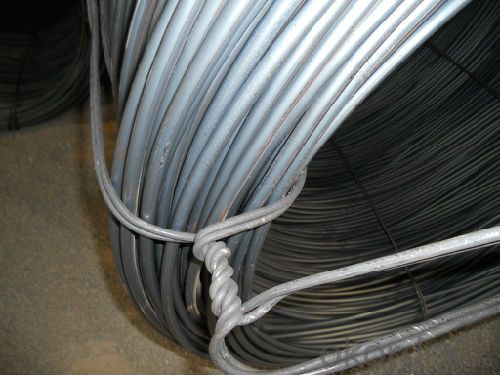
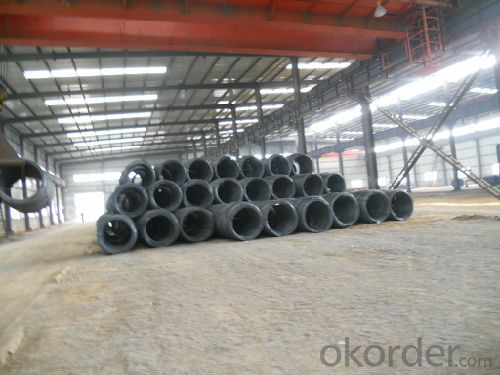
- Q: How is steel wire rod used in the manufacturing of wire forms for material handling?
- Steel wire rod is an essential component in the manufacturing of wire forms for material handling. It serves as the primary raw material that is transformed into various wire forms such as hooks, loops, and coils, which are widely utilized in material handling applications. The process begins with the steel wire rod being subjected to various manufacturing techniques such as drawing and rolling. These processes help to refine and shape the steel wire rod into the desired dimensions and properties required for material handling applications. The resulting wire is then further processed and treated to enhance its strength, durability, and resistance to corrosion. Once the steel wire rod has been transformed into wire forms, it is used in a multitude of ways within material handling equipment. For instance, wire forms are commonly used to create hooks that are attached to lifting devices such as cranes or hoists. These hooks provide a secure and reliable means of lifting and transporting heavy loads. Additionally, wire forms can be shaped into loops that are utilized as handles or gripping mechanisms on material handling tools and equipment. These loops enable operators to safely manipulate or control the movement of objects during material handling processes. Wire forms can also be coiled into springs that are employed in various material handling applications. These springs provide flexibility, shock absorption, and resistance to deformation, thereby ensuring the smooth and efficient operation of material handling equipment such as conveyor systems. In summary, steel wire rod is a fundamental component used in the manufacturing of wire forms for material handling. Through various manufacturing processes, steel wire rod is transformed into hooks, loops, and coils that are crucial for lifting, gripping, and controlling objects during material handling operations. The versatility and durability of wire forms make them indispensable in a wide range of material handling applications.
- Q: How is steel wire rod used in the manufacturing of wire forms for electrical connectors?
- The production of wire forms for electrical connectors heavily relies on steel wire rod. This wire rod serves as the primary material that is converted into different wire forms, including pins, sockets, and terminals, which are vital elements of electrical connectors. To start the manufacturing process, high-quality steel wire rod is carefully chosen. Typically, carbon steel or stainless steel is used for this purpose. The selection of the wire rod is based on specific properties such as strength, flexibility, and conductivity, ensuring that the resulting wire forms meet the required standards and specifications. Once the appropriate wire rod is selected, it undergoes a series of manufacturing operations. Initially, the wire rod is drawn through a series of dies to reduce its diameter and achieve the desired size. This process, known as wire drawing, is necessary to attain the required thickness and smoothness of the wire form. After wire drawing, the wire rod is straightened and cut into specific lengths. The determination of these lengths is based on the design and dimensions of the wire forms needed for the electrical connectors. This straightening and cutting process ensures uniformity and consistency in size. Subsequently, the wire rod is bent and shaped into the desired form. Specialized machines and tools are used for this purpose, enabling the wire rod to be bent into various configurations such as loops, hooks, or specific geometrical shapes. These wire forms are designed to fit and connect with other components of the electrical connectors. Once the wire forms are shaped, they undergo additional processes such as heat treatment or plating. These treatments enhance the mechanical properties of the wire forms and improve their resistance to corrosion. As a result, the wire forms can withstand demanding conditions and provide reliable connectivity in electrical applications. In conclusion, the role of steel wire rod in the manufacturing of wire forms for electrical connectors is critical. Through a series of manufacturing processes, the wire rod is transformed into various wire forms that are essential components of electrical connectors. These wire forms ensure reliable connectivity and proper functioning of electrical systems.
- Q: How is steel wire rod used in the manufacturing of wire for shopping baskets?
- Steel wire rod is used in the manufacturing of wire for shopping baskets by being drawn into thin strands or wires, which are then woven or welded together to form the basket structure. The high strength and durability of steel wire rod ensures that the shopping baskets can withstand heavy loads and frequent use, making them reliable and long-lasting for commercial and retail applications.
- Q: What are the main factors influencing the choice of steel wire rod order storage tracking options?
- There are several main factors that influence the choice of steel wire rod order storage tracking options. Firstly, the size and complexity of the storage facility play a significant role in determining the tracking options. If the facility is large and has multiple storage areas or racks, it becomes essential to have a comprehensive tracking system that can accurately locate and monitor each order of steel wire rod. Secondly, the frequency and volume of incoming and outgoing orders also impact the choice of tracking options. If the facility handles a high volume of orders on a regular basis, a real-time tracking system that provides instant updates on the status and location of each order becomes crucial for efficient operations. Thirdly, the level of automation in the storage facility is another factor to consider. If the facility is highly automated, with robotic systems handling the movement and storage of steel wire rod, the tracking options should integrate seamlessly with the automation system to ensure accurate and synchronized tracking of orders. Additionally, the specific requirements and preferences of the customers and suppliers can influence the choice of tracking options. Some customers may require real-time updates and visibility into the status of their orders, while others may prioritize cost-effectiveness or simplicity. Similarly, suppliers may have their own tracking systems in place, which need to be compatible with the storage facility's tracking options. Lastly, the overall budget allocated for implementing and maintaining the tracking system is an important consideration. More advanced tracking options, such as RFID or barcode systems, may require higher upfront investment and ongoing maintenance costs. Therefore, the financial resources available will impact the chosen tracking options. In conclusion, the choice of steel wire rod order storage tracking options is influenced by factors such as the size and complexity of the storage facility, the frequency and volume of orders, the level of automation, customer and supplier requirements, and budget constraints. By carefully considering these factors, an appropriate tracking system can be selected to streamline operations and enhance efficiency in managing steel wire rod orders.
- Q: What are the main factors affecting the corrosion resistance of steel wire rod?
- The main factors affecting the corrosion resistance of steel wire rod include the composition of the steel, the presence of impurities or alloying elements, the surface condition and finish of the wire rod, the environment in which it is exposed to, and the presence of protective coatings or treatments.
- Q: How is steel wire rod used in the production of nails?
- Steel wire rod is used in the production of nails as it serves as the primary raw material for manufacturing nails. The wire rod is first drawn through a series of dies to reduce its diameter, resulting in a long, slender wire. This wire is then cut into the desired lengths and fed into a nail-making machine. The machine shapes and forms the wire into nails, which are then further processed and finished before being packaged for sale. Thus, steel wire rod plays a crucial role in the entire nail production process, serving as the foundation for creating durable and reliable nails.
- Q: How is steel wire rod stored and handled to prevent corrosion?
- Steel wire rod is stored and handled in a way that prevents corrosion by implementing various protective measures. Firstly, it is stored in a dry, well-ventilated area to minimize exposure to moisture. Additionally, the wire rod is often coated with a rust-resistant material, such as zinc or a special anti-corrosion coating, to provide an extra layer of protection. Furthermore, proper handling techniques are employed to prevent any damage to the protective coating, ensuring that the wire rod remains safeguarded against corrosion.
- Q: What are the main factors influencing the choice of steel wire rod quality standards?
- The main factors influencing the choice of steel wire rod quality standards include the intended application or use of the wire rod, industry regulations and standards, customer requirements, and the overall quality and performance expectations of the end product. Additionally, factors such as cost, availability, and the reputation of the supplier or manufacturer may also play a role in determining the standards for steel wire rod quality.
- Q: What are the environmental impacts of producing steel wire rod?
- The production of steel wire rod can have various environmental impacts, both during the extraction of raw materials and the manufacturing process. Here are some of the key environmental impacts associated with producing steel wire rod: 1. Resource extraction: Steel wire rod is primarily made from iron ore, which requires extensive mining activities. These mining operations can lead to deforestation, habitat destruction, and soil erosion. Furthermore, the extraction and transportation of iron ore contributes to greenhouse gas emissions and air pollution. 2. Energy consumption: The production of steel wire rod involves several energy-intensive processes, such as smelting, refining, and shaping. These processes typically rely on fossil fuels, such as coal and natural gas, which release large amounts of carbon dioxide into the atmosphere. High energy consumption not only contributes to climate change but also depletes non-renewable resources. 3. Air and water pollution: The manufacturing process for steel wire rod can release various pollutants into the air and water. During smelting, emissions of sulfur dioxide, nitrogen oxides, and particulate matter can contribute to air pollution and acid rain. Water pollution can occur through the discharge of wastewater containing heavy metals, oil, and chemicals used in the production process, potentially contaminating nearby water bodies. 4. Waste generation: Steel wire rod production generates significant amounts of waste materials, including slag, dust, and sludge. These waste products often contain harmful substances, such as heavy metals and toxic chemicals, which can pollute the environment if not properly managed. Waste disposal can also contribute to land degradation and the depletion of natural resources. 5. Carbon emissions: Steel production, including the production of wire rod, is a major contributor to global carbon emissions. The high temperatures required to convert iron ore into steel result in the release of large amounts of carbon dioxide. Additionally, the use of fossil fuels in the manufacturing process further adds to the carbon footprint of steel wire rod production. To mitigate these environmental impacts, the steel industry has been adopting various measures such as implementing cleaner technologies, improving energy efficiency, and reducing reliance on fossil fuels. Additionally, recycling steel scrap can significantly reduce the environmental burden associated with steel wire rod production.
- Q: How are steel wire rods used in the production of screws and bolts for construction?
- Steel wire rods are an essential component in the production of screws and bolts for construction purposes. These rods serve as the raw material for manufacturing these fasteners. To begin with, steel wire rods are first processed through a series of manufacturing steps. They are initially drawn through a series of dies to reduce their diameter and increase their length. This process is known as wire drawing, and it helps in achieving the desired size and strength of the wire rod. Once the wire rods are drawn to the required dimensions, they are then cut into smaller lengths that are suitable for the production of screws and bolts. These lengths are often referred to as blanks or billets. The next step involves the threading of these blanks to create the screw or bolt shape. This threading process is typically done using specialized machines that cut or roll grooves onto the surface of the wire rods. These grooves are what enable the screws and bolts to effectively grip into their respective materials, providing a secure connection. After the threading process, the blanks are further processed to add various features, such as the head shape, drive type (such as slotted, Phillips, or hex), and any additional coatings or finishes required for corrosion resistance. This is typically done through machining or forging processes, depending on the desired specifications of the screws and bolts. Once the screws and bolts are formed, they undergo quality control checks to ensure that they meet the necessary standards for strength, dimensions, and overall functionality. This includes testing for factors like tensile strength, hardness, and dimensional accuracy. Finally, the screws and bolts are packaged and distributed for use in construction projects. These fasteners play a crucial role in joining various components of a structure together, providing stability, strength, and longevity to the overall construction. They are widely used in applications such as framing, fastening walls, securing beams, and connecting various building materials. In summary, steel wire rods are used in the production of screws and bolts for construction by serving as the raw material that is processed, threaded, and shaped into fasteners with specific features and properties. These fasteners are vital for the structural integrity and reliability of construction projects, making steel wire rods a crucial component in the construction industry.
Send your message to us
GB Hot Rolled Wire Rod 1008b
- Loading Port:
- China Main Port
- Payment Terms:
- TT or LC
- Min Order Qty:
- -
- Supply Capability:
- -
OKorder Service Pledge
OKorder Financial Service
Similar products
Hot products
Hot Searches
Related keywords
